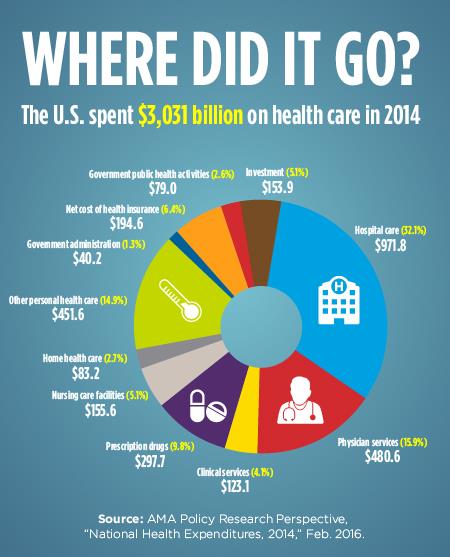With all the talk about rising health care costs, you may be wondering how those vital dollars are being spent. A new analysis answers this question.
A close look at national health expenditures can offer physicians a clearer vision of the total costs and funding that are required each year to keep the health care system functioning. A new analysis (log in) from the AMA sheds light on health care spending.
How our health care dollars are spent
In 2014, the last year for which data are available, U.S. health expenditures were more than $3.0 trillion—which breaks down to $9,523 per person. This reflects a growth rate of 5.3 percent over 2013. “In comparison,” the analysis said, “spending grew by 2.9 percent in 2013 and by an average of 4.0 percent per year” from 2007 to 2012.
“Despite the uptick,” the analysis said, “the 5.3 percent growth rate is still low by historical standards.”
“Important factors behind the acceleration in growth include the coverage expansions of the Affordable Care Act (ACA) as well as the introduction of new drug treatments for hepatitis C, cancer and multiple sclerosis,” the analysis said.
Out of that $3.0 trillion, only 15.9 percent went to physician services. Furthermore, physician spending grew by an average of only 4.1 percent per year between 2004 and 2014, which is 1.5 percentage points lower than the average annual growth rate for hospital spending and a full 2 percentage points lower than that for clinical spending, showing physician spending is not the main driver behind rising health care costs.
On the other hand, prescription drug spending rose 12.2 percent in 2014, marking an abrupt departure from growth rates of recent years. “There hadn’t been double digit growth in this category since 2003,” the analysis said, “and post-2006 growth rates had remained well below 6 percent.” More than one-third of the new drug spending was from new treatments for hepatitis C.
Investigating a longer window of spending
The analysis also investigates the changes in health care spending over both 25 year and 50 year windows to present the patterns that allow analysts to look at short-term changes in a broader context.
The ACA Medicaid expansion’s effect on spending is evident in 2014. Medicaid spending increased by 11 percent—the largest single year increase since 2001—and its share of spending increased from 15.5 percent to 16.4 percent.
The most dramatic change over the past 10 years was in the share of spending paid for by Medicare, which increased from 16.4 percent of spending to 20.4 percent of spending between 2004 and 2014. Changes in the share of spending paid for by Medicare and Medicaid are tied to changes in program expansion and payment policy as well as economic cyclical factors for Medicaid.
Private health insurance has historically been the largest source of funds for health care spending since the 1970s. It continued this trend in 2014 with a 32.7 percent share of the pie, followed by Medicare and Medicaid—these three sources account for the majority of payments in the health care system. The smallest source of funds was out of pocket spending, whose share has continued to trickle downward over the past 50 years from a high of over 40 percent to only 10.9 percent in 2014.
Visit the AMA’s spending in health care Web page for further insight.




